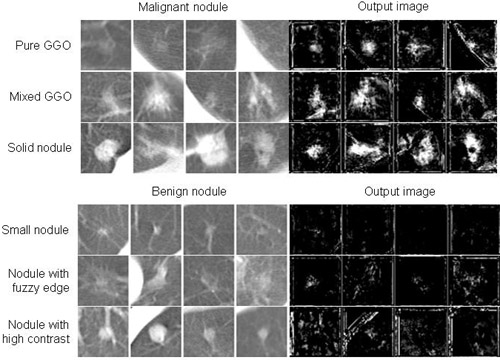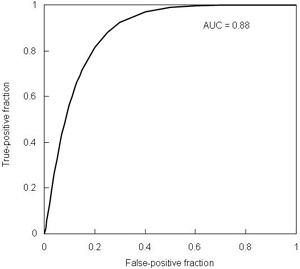Computer-aided Diagnostic Scheme for Distinction between Benign and Malignant Nodules in Thoracic Low-Dose CT by Use of a Massive-Training Artificial Neural Network
Low-dose helical CT (LDCT) is being applied as a modality for lung cancer screening. It may be difficult, however, for radiologists to distinguish malignant from benign nodules in LDCT. Our purpose in this study was to develop a computer-aided diagnostic (CAD) scheme for distinction between benign and malignant nodules in LDCT by use of a massive-training artificial neural network (MTANN). The MTANN is a trainable, highly nonlinear filter based on an artificial neural network. To distinguish malignant nodules from six different types of benign nodules, we developed a multiple MTANN scheme (Multi-MTANN) consisting of six expert MTANNs arranged in parallel. Each of the MTANNs was trained by use of input CT images and teaching images containing an estimate of the distribution for a “likelihood of being a malignant nodule,” i.e., the teaching image for a malignant nodule contains a two-dimensional Gaussian distribution and that for a benign nodule contains zero. Each MTANN was trained independently with ten typical malignant nodules and ten benign nodules from each of the six types. In the output images of the trained MTANNs, malignant nodules are represented by light distributions, whereas benign nodules are mostly dark. The outputs of the six MTANNs were combined by use of an integration ANN such that the six types of benign nodules could be distinguished from malignant nodules. After training of the integration ANN, our scheme provided a value related to the likelihood of malignancyEof a nodule, i.e., a higher value indicates a malignant nodule, and a lower value indicates a benign nodule. Our database consisted of 76 primary lung cancers in 73 patients and 413 benign nodules in 342 patients, which were obtained over 3 years from a lung cancer screening program on 7,847 screenees with LDCT for three years in Nagano, Japan. The performance of our scheme for distinction between benign and malignant nodules was evaluated by use of receiver-operating characteristic (ROC) analysis. Our scheme achieved an AUC (area under the ROC curve) value of 0.882 in a leave-one-out cross-validation test. Our scheme correctly identified 100% (76/76) of malignant nodules as malignant, whereas 48% (200/413) of benign nodules were identified correctly as benign. Therefore, our scheme may be useful in assisting radiologists in the diagnosis of lung nodules in LDCT

Malignant nodules with three major types of patterns, i.e., pure ground-glass opacity (GGO), mixed GGO, and solid nodule, various benign nodules, and the corresponding output images of the trained MTANN.

ROC curve for the MTANNs in distinction between 76 malignant nodules and 413 benign nodules in a leave-one-out cross-validation test.

